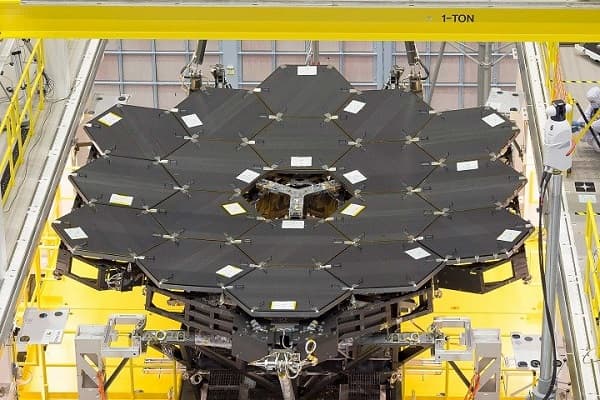NASA Completes Assembly of James Webb Space Telescope's Primary Mirror
Just last month, NASA released a #-Link-Snipped-# stating it was in the process of installing a gigantic mirror in its James Webb Space Telescope. It mentioned that it was using a robotic arm to place the individual segments of the composite mirror. The claim was promising, but it kept us <a href="https://www.crazyengineers.com/threads/nasa-uses-robotic-arm-to-install-mirrors-in-its-webb-telescope.86658">NASA Uses Robotic Arm To Install Mirrors In Its Webb Telescope</a> on how much time the development process would take. Now, according to the latest official document issued by NASA, the 18th and final primary mirror segment has been installed in what is being called the biggest and most powerful space telescope ever.

The James Webb is the collaborative effort of NASA, the European Space Agency and the Canadian Space Agency, and is widely seen as the successor of the Hubble Telescope in exploring “deep spaceâ€. The project has also received assistance from Harris Corporation, an American communications company, defence contractor and IT services provider.
The high-precision robotic arm, called The Primary Mirror Alignment and Integration Fixture, installed the segments one after one, each of which is hexagonal-shaped, about 4.2 feet across and 88 pounds heavy. The mirror, a combination of all such segments, will remain folded during launch. In space, it will unfold to a circular shape having a diameter of 21.3 feet.
Bills Ochs, project manager for the Webb, points out that the team is now looking at installing the subsequent optics as well as conducting tests on the readied components to see if they can withstand the impact of a rocket launch. At the same time, Lee Feinberg, optical telescope element manager at NASA’s Goddard Space Flight Center in Greenbelt, Maryland, regards this establishment as a “culmination of over a long decade design, manufacturing, testing†and rightly so.
The Webb Telescope will focus on studying the history of the universe in phases, finding solar systems that can support life, and the development of our solar system. It is set to launch from French Guiana in 2018 aboard an Ariane 5 rocket.
Source: #-Link-Snipped-#

The James Webb is the collaborative effort of NASA, the European Space Agency and the Canadian Space Agency, and is widely seen as the successor of the Hubble Telescope in exploring “deep spaceâ€. The project has also received assistance from Harris Corporation, an American communications company, defence contractor and IT services provider.
The high-precision robotic arm, called The Primary Mirror Alignment and Integration Fixture, installed the segments one after one, each of which is hexagonal-shaped, about 4.2 feet across and 88 pounds heavy. The mirror, a combination of all such segments, will remain folded during launch. In space, it will unfold to a circular shape having a diameter of 21.3 feet.
Bills Ochs, project manager for the Webb, points out that the team is now looking at installing the subsequent optics as well as conducting tests on the readied components to see if they can withstand the impact of a rocket launch. At the same time, Lee Feinberg, optical telescope element manager at NASA’s Goddard Space Flight Center in Greenbelt, Maryland, regards this establishment as a “culmination of over a long decade design, manufacturing, testing†and rightly so.
The Webb Telescope will focus on studying the history of the universe in phases, finding solar systems that can support life, and the development of our solar system. It is set to launch from French Guiana in 2018 aboard an Ariane 5 rocket.
Source: #-Link-Snipped-#
0
